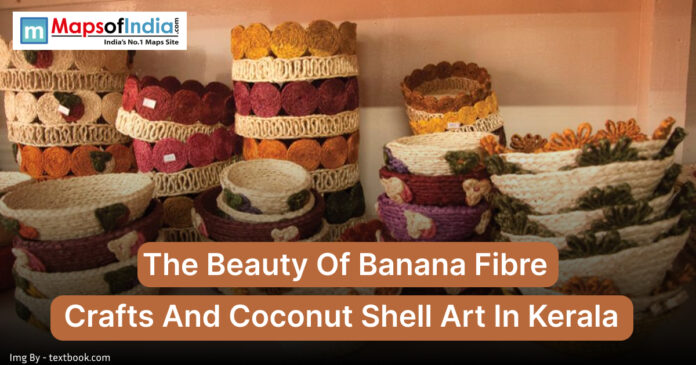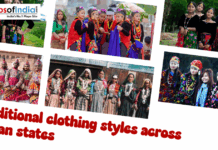Kerala is known as India’s tropical paradise for its landscapes and cultural heritage. In which there are traditional crafts that transform natural materials into stunning works of art. Banana fibre crafts and coconut shell art have properties like sustainability, aesthetic appeal, and also cultural significance. These crafts which are rooted in Kerala’s agrarian traditions use unlimited local resources like banana plants and coconut shells to create environment friendly products that are easy for modern consumers to taste.
The Art of Banana Fiber Crafts
Origins and Process
Banana fibre crafts are a testament to Kerala’s ingenuity in utilizing agricultural byproducts like banana plants, a staple crop in Kerala, to yield fibres from their pseudo-stems after fruit harvesting. According to a 2024 study, Kerala’s banana cultivation generates significant crop residue, with approximately 60% of the plant’s biomass available for fibre extraction. Local craftsmen extract these fibres through an extended manual process which involves stripping, drying, and weaving the fiber.
- Extraction: The pseudo-stem is cut, and its layers are peeled which leads to obtaining fibrous strands.
- Processing: In this process fibres are washed, dried in the sun, and sometimes dyed using natural dyes like turmeric or indigo.
- Crafting: Artisans weave or braid the fibres into products like baskets, mats, bags, and coasters.
Due to the abundance of banana plants, Kerala produces over 600,000 metric tons of bananas annually. Fibre crafts are a sustainable practice that reduces waste and promotes circular economies.
Aesthetic and appeal
Products made from Banana fibre sell at high prices in the market places because of their properties such as being lightweight, durable, and biodegradable. This product has its own appeal in the market. This fibre has natural sheen and texture which lend a rustic yet elegant charm to items like handbags and home decor. banana fibre baskets which often feature geometric weaves, appealing to specific environment friendly consumers on a global level.
Market Insights
In the global market, there is a greater demand for sustainable craft. The global market for eco-friendly handicrafts was valued at $718 million in 2023, with a projected CAGR of 6.5% through 2030. India, with Kerala as a key contributor, accounts for 12% of this market. Reports from online platforms like Etsy and Amazon show a 30% increase in searches for banana fibre products from India every year. Which shows their rising popularity in the global market. Districts in the state of Kerala where this craft exists which are Thrissur and
Kottayam has tapped into this trend with cooperatives exporting to Europe and North America.
The Craftsmanship of Coconut Shell Art
Historical Context and Techniques
Coconut shell art is another cornerstone of Kerala’s craft heritage which transforms discarded shells into stunning decorative and functional items. Wayanad, a well-known place for this craft, has changed the raw material from its original use as a fuel source to a globally known art form.
Cleaning and Polishing: Shells are cleaned, sanded, and polished to a glossy finish. Carving and Inlay: Craftsmen carve designs on shells with metal or wood to add more elegance.
Product Creation: The products which are produced in this craft vary from bowls and spoons to jewellery and lampshades.
Versatility and Cultural Significance
Coconut shell art is well known for its versatility. The sturdy shells are made into products which are useful but also have an aesthetic touch. Products like restaurant cutlery sets or ornate boxes sold at high prices at tourist markets. The craft also holds cultural weight which is often featured in festivals like Onam, where shell carved lamps illuminate traditional celebrations. A YouTube video by Our Sacred Space shows the artistic usefulness of combining coconut shells with banana fibre for home decor which shows Kerala’s integrated craft ecosystem.
Economic Impact
Coconut shell crafts contribute significantly to Kerala’s rural economy. A 2023 report estimates that the handicraft sector which includes coconut shell art gives employment to over 50,000 craftsmen in Kerala. women comprising 70% of that workforce. Organisations like the Kerala State Handicrafts Apex Society have boosted exports with coconut shell products priced at $15–50 per item in international markets. A recent study conducted in 2024 on a trade platform shows that there is a 25% increase in demand for products made from coconut shells which happen because of the global shift toward sustainable and environmentally friendly home decor.
Sustainability
Banana fibre and coconut shell crafts align with global sustainability goals. To create this craft they use biodegradable materials which reduce reliance on plastics and synthetic fibres. A recently conducted study emphasizes that banana fibre is 100% biodegradable and requires no chemical processing, unlike cotton or jute. Same way once considered waste, coconut shells are now valued for their durability and low environmental footprint.
Waste Reduction: Kerala’s banana fibre crafts reuses 1.5 million tons of agricultural waste. Carbon Footprint: Products made by hand have a lower carbon footprint than machine produced products.
Community Empowerment: These crafts provide livelihoods to rural local communities. Also to women, which give a boost to the local economy.
A recent study conducted by the Indian Institute of Crafts and Design (IICD) shows that such sustainable practices have established Kerala’s reputation on a global level as a centre for sustainable craftsmanship, attracting environmentally friendly consumers.
Challenges and Opportunities
Even with this craft’s beauty and sustainability, there are some challenges that exist
1. Market Access: Local craftsmen do not have direct access to large global markets, which makes them rely on brokers who reduce profit margins.
- Skill Preservation: The new generations are less interested in pursuing this traditional Craftsmanship.
- Market Competition: In the global market availability of alternatives made from plastic or synthetic made mass products. Those are less costly.
The Steps For a Better Future Of Kerala Crafts
The beauty of banana fibre and coconut shell art lies in their blend of tradition, sustainability, and innovation.
Skill Development: Making skill development training programs to teach modern design techniques while also preserving traditional methods.
Expansion in the E-commerce sector: Making use of e-commerce platforms like Amazon can help to reach the global market.
Tourism: Promoting villages in Kerala as tourist destinations, mostly the villages where craft is done while showing live demonstrations and workshops.
Conclusion
This craft made from things considered as not usable or waste shows Kerala’s rich cultural heritage and sustainable mindset. These businesses empower local communities and also help to preserve the environment. As demand for sustainable products that blend heritage with innovation grows, Kerala craftsmanship will rise. Using digital platforms and government support, these crafts can continue captivating the world and showing that beauty and sustainability go hand in hand.




